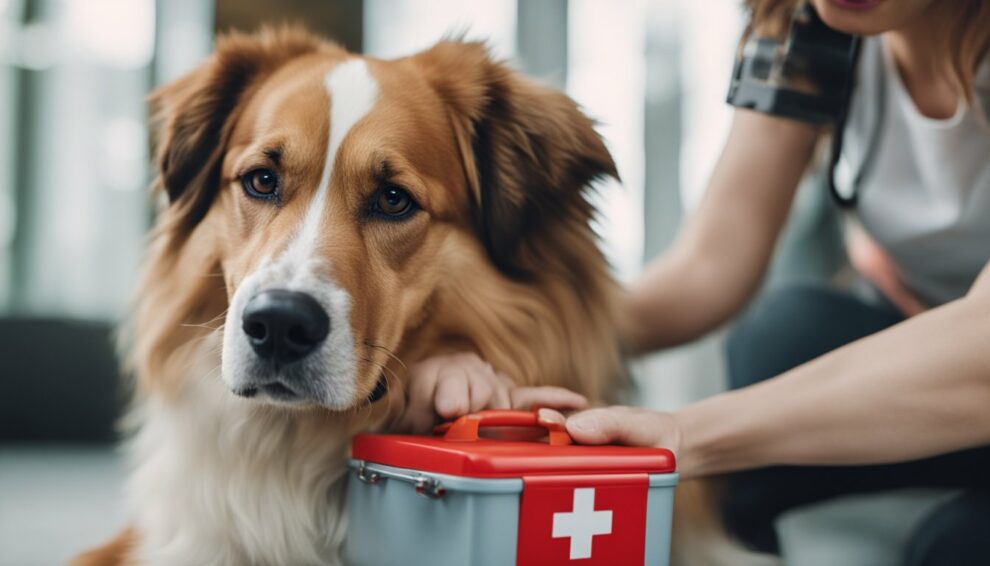Eye injuries in dogs can happen at any time and can range from mild irritations to severe traumas that require immediate attention.
Whether they’re exploring the underbrush, playing with other animals, or simply the victims of an unfortunate accident, dogs can sustain injuries to their eyes that may threaten their vision and overall well-being.
Recognizing the signs of an injury and understanding how to respond are critical in ensuring your pet receives the care they need.

When a dog sustains an eye injury, it is often noticeable by symptoms such as squinting, excessive tearing, redness, or even bleeding.
These indicators should prompt any pet owner to take swift action.
While minor issues like superficial scratches might be treated with home care, more serious conditions like corneal ulcers, protrusions of the eye, or penetrating injuries require emergency veterinary treatment to preserve eyesight and prevent complications.
Knowing when to seek veterinary help is vital.
Time is of the essence, especially when dealing with eye injuries where every minute counts.
Owners should be aware of the various causes and remedies for dog eye injuries and be prepared to act quickly should their dog suffer an eye emergency.
Providing prompt and proper care can make a significant difference in the outcome for your dog’s eye health.
Recognizing Eye Injuries in Dogs

When a dog experiences an eye injury, prompt identification and care are crucial for their well-being.
It’s important to be able to recognize the symptoms of eye trauma so that one can seek immediate veterinary attention.
Common Signs of Eye Trauma
Squinting is often one of the first signs a dog may display when experiencing discomfort due to an eye injury.
A dog may also exhibit increased tear production, which could be an attempt to clear irritants or soothe the eye.
Owners should note any redness or inflammation around the eye, as these can indicate serious underlying issues.
Dogs might instinctively paw at their affected eye or blink frequently if they are in pain or to protect the eye from further harm.
Types of Eye Injuries
Eye injuries in canines can range from mild to severe, affecting various parts of the eye.
Some common injuries include corneal ulcers, foreign bodies in the eye, and blunt trauma.
Each type of injury may produce specific symptoms:
- Corneal Ulcers: Can cause intense discomfort, manifesting as constant squinting or pawing at the eye.
- Foreign Bodies: A dog with a foreign object in its eye might have pronounced tear production and redness.
- Blunt Trauma: Likely to lead to severe inflammation and possibly an irregular appearance of the eye.
Owners observing any of these signs should seek professional assistance, as indicated by the wealth of information found on South Seattle Vet and PetMD.
First Aid for Canine Eye Injuries

When a dog sustains an eye injury, quick and proper first aid is crucial.
The focus is on minimizing pain, preventing further injury, and preparing for a visit to the veterinarian.
Immediate Steps
-
Keep the Dog Calm: Speak in soft tones and maintain a soothing demeanor to help the dog stay as relaxed as possible.
-
Assessment: Gently examine the area to determine the extent of the injury.
Be careful not to exert pressure on the injured eye.
-
Saline Flush: Carefully flush the eye with a sterile saline solution to help remove any debris.
Avoid using any solution not specifically intended for eye use.
-
Cold Compress: Apply a clean cloth dampened with cold water to the area around the eye to reduce swelling and provide comfort.
Do not apply ice directly to the eye.
-
E-collar: Place an Elizabethan collar (e-collar) or cone on the dog to prevent them from pawing at or rubbing the injured eye.
What to Avoid Doing
-
Do not use medicated ointments or drops without veterinary guidance, as some can cause harm to the canine eye.
-
Avoid trying to treat serious injuries at home, such as an eye out of its socket or evident deep cuts; these require immediate professional care.
-
Never scold the dog if they are resistant; this can cause stress, potentially aggravating the situation.
Remember, after administering first aid, bring the dog to a veterinarian immediately for a thorough examination and appropriate treatment.
When to Seek Veterinary Attention

When a pet’s eyes are at risk, immediate and appropriate care is essential.
Delaying treatment may lead to more serious damage or permanent vision loss.
Urgency of Eye Injuries
Eye injuries in dogs are serious and require prompt veterinary attention. Owners should be alert for signs such as:
- Squinting or excessive blinking
- Visible trauma to the eye area
- Unusual discharge or blood
- The dog pawing at the eye
- Changes in the eye’s appearance (e.g., cloudiness)
- Apparent pain or discomfort
If any of these signs are present, it is critical to seek veterinary care without delay to prevent complications or deterioration of the dog’s condition.
Choosing the Right Professional
In the case of eye injuries, a general veterinarian is often the first point of contact. They can handle many urgent eye conditions.
However, for severe or complicated cases, a veterinary ophthalmologist may be required.
These specialists have advanced training to diagnose and treat eye conditions, potentially saving a dog’s eyesight.
It is advisable to contact a vet immediately to assess the situation and determine the next steps, whether that means immediate emergency care or referral to a specialist.
The quicker a dog receives care after an injury, the better the chances of a successful outcome.
Treatment Options for Injured Eyes

When a dog sustains an eye injury, timely and appropriate treatment is key to minimizing damage and facilitating healing.
Each case may require a tailored approach depending on the severity and type of injury.
Medication and Non-surgical Care
For non-severe eye injuries such as corneal ulcers, a veterinarian will often prescribe medication to prevent or treat infection and promote healing.
Commonly used medications include:
- Antibiotics: to fight bacterial infections.
- Anti-inflammatory drugs: to reduce swelling and discomfort.
Non-surgical care may also involve:
- Eye drops or ointments: to keep the eye lubricated and aid healing.
- E-collar: to prevent the dog from scratching and causing further damage.
These treatments aim to reduce the risk of scarring and speed up the healing process.
Surgery and Rehabilitation
In the event of serious eye injuries, surgery may be necessary to repair the damage.
Surgical procedures can range from removing foreign objects to more complex ones like repairing a torn cornea.
Key post-surgical steps include:
- Close monitoring: to assess the healing progress.
- Follow-up care: which may involve additional medication or adjustments to treatment.
Post-surgery, a period of rehabilitation is crucial to ensure complete recovery. It generally includes:
- Restricted activity, to allow the eye to heal without additional stress.
- Continued administration of medications as prescribed by the veterinarian.
Surgical intervention aims to restore function as much as possible and reduce the chance of long-term scarring or vision impairment.
Prevention and Long-Term Care

Keeping a dog’s eyes safe involves proactive measures to prevent injury and consistent care to maintain ocular health.
These steps are vital to protecting their vision and preventing long-term health issues that could lead to complications or even blindness.
Avoiding Future Injuries
To prevent future eye injuries in dogs, one should ensure their environment is safe from sharp objects and hazards.
Protection can also come in the form of canine eye wear, especially if they frequently engage in activities that pose a risk to their eyes, such as riding in a car with their head out the window or running through heavy brush.
It’s also crucial to supervise play, particularly with breeds known for their protruding eyes.
- Routine Checks: Regularly inspect your dog’s eyes for any irregularities or signs of discomfort.
- Hygiene: Maintain cleanliness to avoid infections which may compromise eye integrity.
- Secure Environment: Remove potential hazards in the home and yard that could cause harm.
Ocular Health Maintenance
Long-term care for a dog’s eye health should include regular visits to the veterinarian for check-ups.
They can screen for health issues that may affect the eyes and offer treatment options to maintain ocular health.
Dogs with chronic eye conditions may need medication or special eye drops to manage their condition.
- Balanced Diet: Provide a diet rich in vitamins and nutrients that support eye health.
- Eye Drops/Medications: Use as prescribed by a veterinarian for existing conditions.
- Veterinary Care: Keep up with regular veterinary appointments for early detection and intervention.
Consistent preventative measures and dedicated care help safeguard a dog’s eyes and can significantly reduce the risk of injury and disease.















